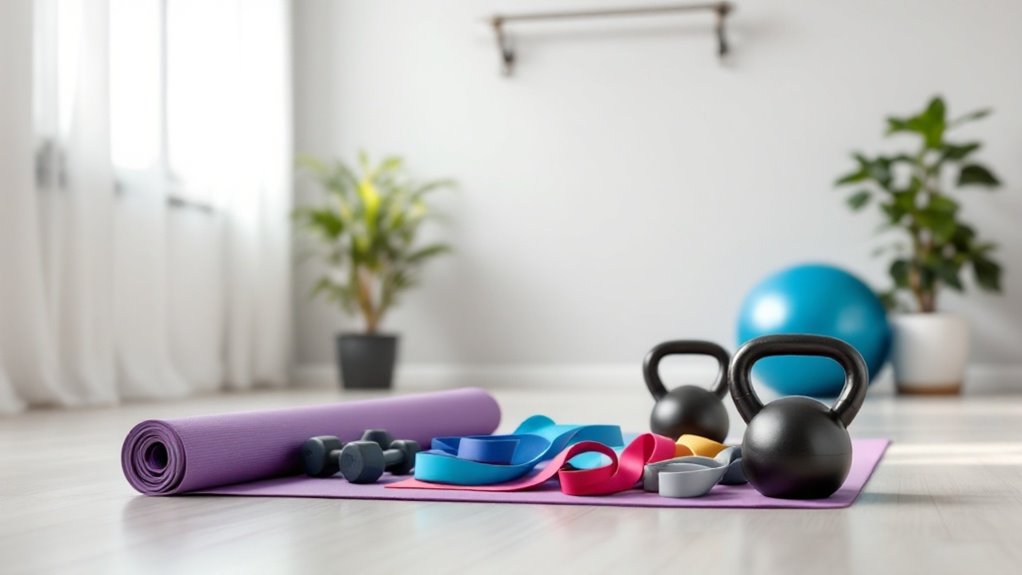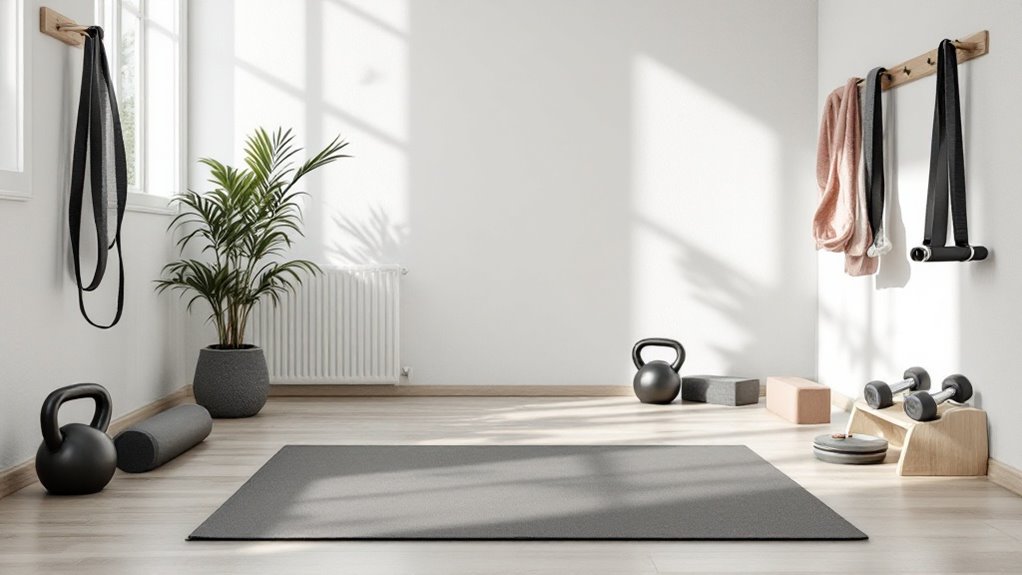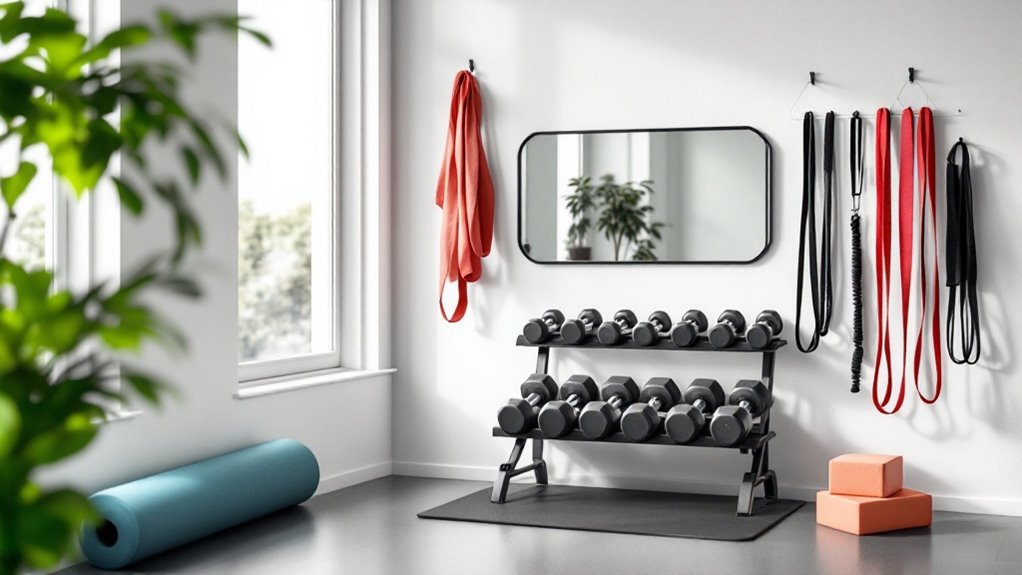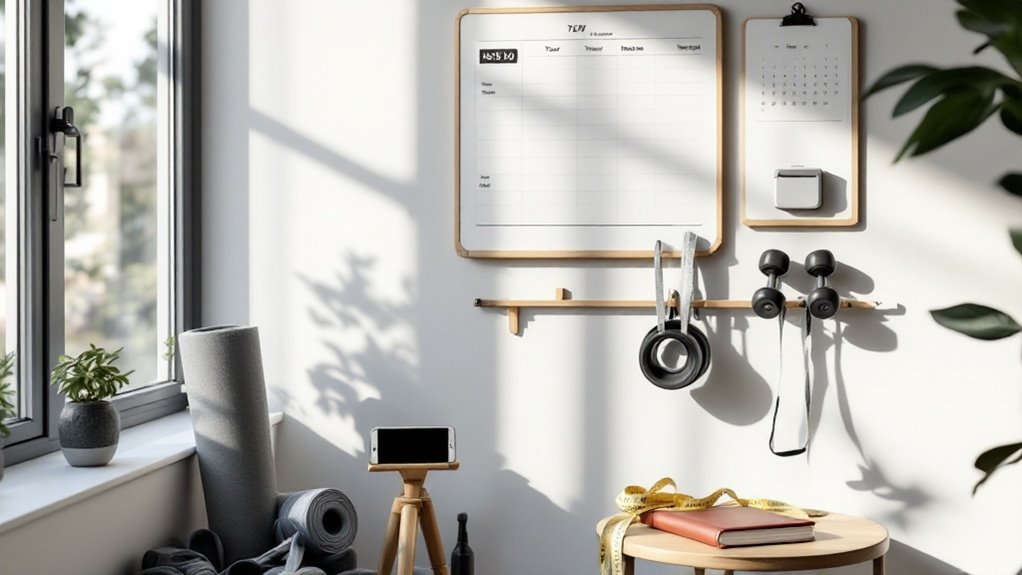Home Gym Workout

Home gym workouts require minimal equipment while maximizing results through consistent effort and proper form. Essential gear includes adjustable dumbbells, resistance bands, and exercise mats for a foundation of strength training and cardio routines. A well-structured program combines 3-4 weekly strength sessions with 2-3 cardio workouts, focusing on compound movements and proper technique. Regular progress tracking through photos and workout logs guarantees steady advancement. The journey to peak fitness begins with the first rep.
Key Takeaways
- Start with essential equipment like adjustable dumbbells, resistance bands, and an exercise mat for a complete home workout setup.
- Perform compound exercises targeting multiple muscle groups 3-4 times weekly for optimal strength gains.
- Combine strength training with cardio by incorporating HIIT workouts and steady-state exercises 2-3 times per week.
- Master proper form on bodyweight exercises before progressing to weighted movements to prevent injury.
- Track workouts using a fitness journal and take progress photos every two weeks to monitor improvement.
Essential Equipment for Your Home Workout Space

Creating an effective home gym starts with acquiring the right foundational equipment that enables a complete full-body workout routine. A solid setup includes adjustable dumbbells, resistance bands, and a sturdy exercise mat as the core essentials.
For those ready to level up, adding a pull-up bar, kettlebell, and stability ball expands workout possibilities dramatically. These tools create the foundation for strength training, cardiovascular fitness, and mobility work – the three pillars of a well-rounded fitness program.
Remember: quality trumps quantity. Invest in versatile equipment that serves multiple purposes rather than cluttering your space with single-use items that collect dust. Setting up your home gym is an important step in making sustainable lifestyle changes that support your long-term fitness goals.
Building an Effective Exercise Routine

When designing an effective exercise routine, experienced fitness professionals recommend starting with a structured plan that combines strength training, cardiovascular activity, and flexibility work.
A well-rounded routine should include 3-4 strength training sessions weekly, targeting major muscle groups through compound exercises like squats, deadlifts, and bench presses.
Cardiovascular training should occur 2-3 times per week, incorporating both high-intensity interval training (HIIT) and steady-state cardio.
Mix up your cardio with both intense intervals and steady endurance work to maximize heart health and fat-burning potential.
Flexibility work, including dynamic stretching and mobility exercises, should bookend each workout session.
Tracking progress through measurable goals and adjusting the routine every 4-6 weeks guarantees continuous improvement and prevents plateaus.
Following a 30-day workout plan provides a structured framework to establish consistent exercise habits while gradually building strength and endurance.
Proper Form and Safety Guidelines

Proper training form serves as the foundation for safe and effective home workouts. Following correct exercise technique prevents injuries while maximizing results. Athletes should maintain neutral spine positioning, involve core muscles, and control movements throughout each rep.
Basic safety guidelines include warming up properly, starting with lighter weights, and progressing gradually. Exercisers must guarantee adequate space around equipment and inspect gear regularly for wear. Having a spotter or recording videos helps identify form issues.
For beginners, mastering bodyweight exercises first builds the necessary movement patterns. When fatigue sets in, it's essential to maintain proper form or end the set to prevent compensation injuries. Using a strength training chart helps track progress and ensures steady advancement in weight and repetitions over time.
Tracking Progress and Setting Goals

How can athletes improve their fitness journey without a clear roadmap to success? Tracking progress and setting goals are essential components of any effective home workout routine.
By monitoring performance metrics and establishing measurable objectives, individuals can optimize their training outcomes.
- Use a fitness journal to record daily workouts, including sets, reps, and weights.
- Take progress photos every two weeks to document physical changes.
- Set SMART goals (Specific, Measurable, Achievable, Relevant, Time-bound) for strength and endurance.
- Monitor key performance indicators like body measurements, rest periods, and recovery time.
These tracking methods provide accountability and motivation while helping identify areas for improvement in the fitness journey.
Creating a printable exercise calendar helps maintain consistency by providing a visual schedule of planned workouts that can be physically checked off upon completion.
Frequently Asked Questions
How Long Should I Wait Between Workouts to Avoid Overtraining?
Recovery time between workouts depends on several factors: exercise intensity, muscle groups worked, and individual fitness level.
The standard recommendation is 48-72 hours between training the same muscle groups. Full-body workouts typically require 1-2 days of rest between sessions.
Beginners should start with longer rest periods and gradually decrease as their fitness improves.
Signs of overtraining include persistent fatigue, decreased performance, and prolonged muscle soreness.
Can I Do Home Workouts Effectively if I Live in a Small Apartment?
Studies show that 85% of people believe they need significant space for exercise, yet Olympic gymnasts train in areas as small as 36 square feet.
Small apartment workouts can be highly effective using bodyweight exercises, resistance bands, and compact equipment like adjustable dumbbells.
What Time of Day Is Best for Working Out at Home?
The ideal workout time varies by individual preference and schedule.
Morning sessions capitalize on higher testosterone levels and fewer distractions, while evening workouts benefit from increased body temperature and muscle strength.
The key is consistency – choosing a time that can be maintained daily.
Research shows exercise performance peaks between 2-6 PM, but the best time is whenever someone can stick to their routine reliably.
Should I Work Out on an Empty Stomach or After Eating?
Ever wondered why some workouts feel better than others? The timing of meals around exercise can greatly impact performance.
While working out on an empty stomach can boost fat burning for some people, others may feel lightheaded or weak.
The general recommendation is to eat a light meal 2-3 hours before exercising, or a small snack 30 minutes prior, focusing on easily digestible carbohydrates and protein.
How Do I Stay Motivated When Working Out Alone at Home?
Setting clear, measurable goals creates purpose and direction.
Tracking progress through photos, measurements, and workout logs provides tangible evidence of improvement.
Creating a dedicated workout space and scheduling sessions like important meetings maintains structure.
Following fitness influencers, joining online communities, and sharing progress on social media builds accountability.
Music playlists, podcast episodes, and workout apps can boost motivation during solo training sessions.
Final Thoughts
As the fitness journey unfolds within these four walls, each bead of sweat tells a story of transformation. Like a sculptor chiseling away at marble, dedicated home workouts gradually reveal the masterpiece within. Through proper equipment, consistent routines, meticulous form, and goal-driven progress tracking, the home gym becomes more than space – it becomes a personal sanctuary where determination meets destiny, one rep at a time.


